Rohtas Fort
Coordinates: 32°58′7″N 73°34′31″E / 32.96861°N 73.57528°E
| Rohtas Fort | |
|---|---|
| Name as inscribed on the World Heritage List | |
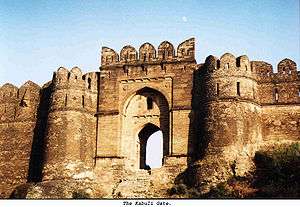 | |
| Type | Cultural |
| Criteria | ii, iv |
| Reference | 586 |
| UNESCO region | Asia-Pacific |
| Inscription history | |
| Inscription | 1997 (21st Session) |
Rohtas Fort (Punjabi, Urdu: قلعہ روہتاس Qila Rohtas) is a historical garrison fort located near the city of Jhelum in Punjab, Pakistan. It was built under Afghan king Sher Shah Suri, to subdue the rebellious tribes of the northern Punjab region, in the 16th century. This fort is about 4 km in circumference. The Rohtas fort was built to crush the local Ghakhar tribes of Potohar, who rebelled against the Sur dynasty after the Mughal emperor Humayun was ousted by the former.
It took eight years to build the fort, it was captured by Mughal emperor Humayun in 1555.[1] Nadir Shah, the Turkic ruler of Persia, Afghan ruler Ahmed Shah Abdali and the Maratha army also camped here during their respective campaigns in the Punjab region. Rohtas was also occasionally used for administrative purposes by the Sikh ruler Ranjit Singh after he captured it in 1825.[2][3]
Reasons of construction
The Fort was commissioned by Afghan king, Sher Shah Suri, the fort was constructed to block Humayun's return to India, who was living in exile in Persia after his defeat in the Battle of Kanauj. The fort lies on the historic GT road between the mountainous region of Afghanistan and the plains of Punjab. The reason of its construction was to suppress the local tribes of the Potohar region, these local tribes were subservient to the Mughal Empire but they refused their allegiance to Sher Shah Suri. Sher Shah ordered to construct the fort to crush the local rebel tribes.[4] It was captured by Mughal emperor Humayun in 1555.
Location
The fort lies eight kilometers south to the present Grand Trunk Road near Dina City within the mountainous region of Jhelum, Pakistani Punjab. The old and historic Shahrah-e-Azam also passes adjacent to the outer northern wall of the fort, remains of which still visible on ground in the shape of pavements and rough roads. Qila Rohtas is situated in a gorge approximately 16 km NW of Jhelum and 9 km from Dina. It was constructed on a hillock where the tiny rainy Kahan river meets another rainy stream called Parnal Khas and turns east towards Tilla Jogian Range. The fort is about 300 feet (91 m) above its surroundings. It is 2,660 feet (810 m) above sea level and covers an area of 12.63 acres (51,100 m2).
Overview of construction
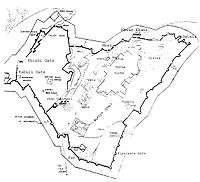
Qila Rohtas is a garrison fort and could hold a force of up to 30,000 men. Due to its location, massive walls, trap gates and 3 Baolis (stepped wells) it could withstand a major siege although it was never besieged.
Most of the fort was built with ashlar stones collected from its surrounding villages such as Tarraki village. Some parts of the fort were built with bricks.
The fort is irregular in shape and follows the contours of the hill it was constructed on. The fort is exactly 5.2 km in circumfereance. A 533 metre long wall divides the citadel (for the Chieftain) from other parts of the fort.
The fortification has 68 bastions (towers) at irregular intervals. Out of the 3 Baolis, one of them is in the citadel and the rest are in the other parts of the fort. One of the Gates (Langar Khani) opens into the citadel and is a trap gate because it is in the direct line of fire of the bastions.
The Khwas Khani gate is an example of double walling. A small enclave on the western side is a citadel within a citadel. It is accessible by only one gate and also had a very fine Baoli which suggests that it was meant for the Chief and his family. In this citadel there is a beautiful Mosque called the Shahi Mosque (Not to be confused with the one in Lahore). There are no palaces in the Fort except for a structure built by Raja Man Singh called the Haveli of Man Singh. It is built on the highest point of the citadel.
Fortification wall
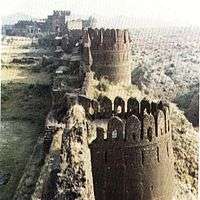
The height of the outer wall varies between 10 and 18 metres. Its thickness varies between 10 and 13 metres. The wall has 2 or 3 terraces and varies in thickness, the maximum being 13 metres near the Mori Gate. The terraces are linked by staircases. The topmost terrace has merlon-shaped battlements. Muskets can be fired from these battlements. Soldiers could also pour molten lead over the walls.
The wall is built in sandstone laid in lime mortar mixed with brick. The gates are in grey ashlar masonry. Some portions have been built using burnt brick.
Gates
The Rohtas Fort has the following 12 gates. All of them are built in ashlar stone.
Sohail Gate

This gate is the best example of masonry in use in the time of Sher Shah. It derives its name from a Saint named Sohail Bukhari buried in the south-western bastion of the gate. Others say that it was named after the Sohail Star which rises on this side of the fort.
It is a double gate rectangular in shape. It is 21.34 metres (70.0 feet) high, 20.73 metres (68.0 feet) wide and 15 metres (49 feet) deep. The central archway is 4.72 metres (15.5 feet) wide. It has an inner and an outer arch which is decorated with beautiful and simple motifs of sunflower. This decoration is repeated in all parts of the Qila.

There are balconies on either side of the central arch. These balconies have a small dome and their sides and bottom are also decorated. Unlike other parts of the Qila which has been built in Afghan-Persian style, the balcony is an example of Hindu architecture. These same balconies can be seen in Haveli Man Singh. There is a small window in the middle of the outer arch. This window is different from the two balconies to either side of the outer arch. It is much simpler that these two balconies.

There are seven merlons on this gate. The bastions are with battlements which have loopholes. These bastions have three levels on the inside. These can be seen if one zooms in the Sohail Gate picture.

The inner side of the gate mirrors the outside but has less decoration. There are no battlements towards the inside and no balconies either. The rooms in the upper storey of this gate have windows that open towards the inside of the Qila. Like the outer arch there is a small window in the middle of the inner arch. The gate now houses a visitors' information center and a Museum set up by the Himalayan Wildlife Foundation.
Shah Chandwali Gate
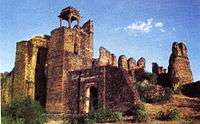
This gate links the citadel to the main fort. It is named after a Saint Shah Chandwali who refused to get his wages for working on this gate. The saint died while still on work and was buried near the gate. His shrine still stands to this day.
This gate is also a double gate. The outer gate, the entrance of which is from the citadel is 13.3 meters wide and 8.23 meters deep. The inner gate is a simple archway which is 3.66 meters wide. There are 12 gates of the fort.
Kabuli Gate


This gate opens to the west and is named “Kabuli” because it faces Kabul. It is a double gate and its opening is 3.15 meters (10.3 feet) wide. It has two bastions on each side. The gate has 5 battlements on top and has stairs leading up to it from the outside. On the southern side of the gate is the Shahi (Royal) Mosque because of which many people also call it Shahi (Royal) Darwaza (Gate or Door). There is a Baoli near this gate.
Shishi Gate

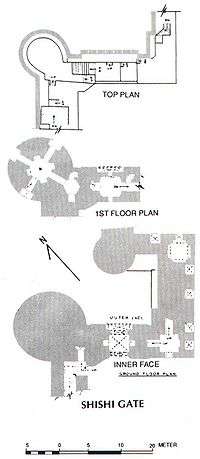
The gate derives its name from the beautiful glazed tiles used to decorate its outer arch. These tiles are the earliest examples of this technique which was later refined in Lahore. These tiles are blue in color.
An inscription on the left side of the gate gives the date of construction of the fort. The inscription is in Persian and is translated as follows
In the Hijri Year 948 came the exalted
At that time constructed the great fort
The emperor is Sher, with long life
There is no match to his good fortune
It was completed by Shahu Sultan
The Hijri year 948 is 1541 CE.
Langar Khani Gate
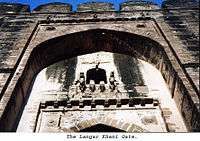
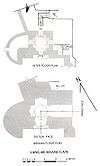
It is a double gate 15.25 meters (50.0 feet) high, 3.5 meters (11 feet) wide with a central arched opening. The oouter arch has a small window like the Sohail Gate. The outer opening leads to a Langar Khana (Mess or Canteen).
There are two bastions on either side of the gate which have kitchen, stores and a well for water. The opening of this gate is L shaped. As soon as one enters from the outer gate one has to turn right.
Talaqi Gate
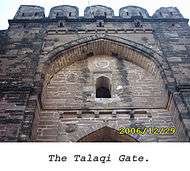
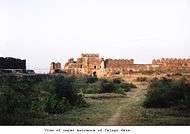
This gate is 15.25 meter high and 13.8 meter wide with two bastions on either side. This gates name derives from “Talaq” (divorce). According to a legend, Prince Sabir Suri entered the gate and had an attack of fever which proved fatal. This was regarded as a bad omen and the name became “Talaqi”.
Mori or Kashmiri Gate
The gate opens to the north and faces Kashmir. This gate opens into one chamber which opens into another.
Khwas Khani Gate
This gate is named after one of Sher Shah Suri’s greatest general, Khwas Khan. This was the original entrance to the Qila (Fort) because outside the gate lies the old GT Road.
It is a double gate. The outer gate is 12.8 meters (42 feet) wide and 8 meters (26 feet) deep. This gate has a bastion and a defensive wall on each side. On the bastions cannons could be deployed. The inner and outer gates are almost mirror images of each other. The top of the gate has five battlements. All of these have loopholes as well as machicolation. Unlike other gates of this Qila, the inner side of the gate has five battlements.
The inner and outer arches have sunflower motifs like the Sohail Gate. The gate also has a room which has windows opening to the inside and the outside.
It is pertinent to mention here that when the Gakhars refused their allegiance to Sher Shah Suri, he launched an expedition to punish them. This resulted in the capture of the Gakhar chief Sarang Khan and his daughter. Sarang Khan was then killed. His daughter was then married to Sher Shah’s favourite general Khwas Khan.
Gatali Gate
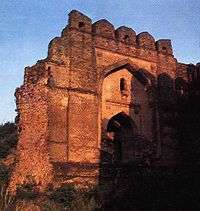
It is a single gate 9.15 meter high and 6.1 meter deep. This gate faces to the village Gatali Ford(ravine) which is called also Patan Gatiali or Gatiyalian, the important point to cross the River Jhelum for the Kashmir Vally, thus the name. other then this village aima afghana's comandar habib khan lodhi wellcomed kashmirian pathan brothers who visit rohtas fort. comandar habib khan lodhi was right hand to king sher shah suri.[5]
Tulla Mori Gate
This is an entrance rather than a gate. It is on the eastern side of the fort. It is about 2 meters wide. There is a bastion next to this entrance.
Pippli Gate
This is a small entrance like the Tulla Mori Gate. It is 2.13 meter wide.
Sar Gate
This is a small entrance seems to be developed by breaking main wall (outer boundary) at latter stage by the locals as a short passage to an adjacent jungle. There is a bastion next to this gate. There is also located a dipilated pond in front of this gate within the fort, since the construction of the fort, for this reason it is now called “Sar Gate” as “Sar” means water pond.
Other buildings
Shahi Mosque

This small mosque is near the Kabuli gate. It has a prayer chamber and a small courtyard. It is the most decorated of the original buildings of the fort. To be ever ready in case of attack, stairs lead directly from the courtyard of this mosque to the top of Kabuli Gate.
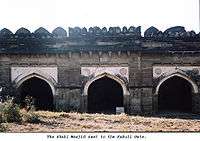
The prayer chamber is 19.2 meter long and 7.3 meter deep. It is divided into 3 equal chambers. There are domes from the inside but from the outside no domes can be seen. There is a small room at the end of these three chambers. This room was for the Pesh Imam (Prayer Leader). This room has a small domed roof from the inside but no outer dome. There is no place for ablution(cleaning up before prayers) in the mosque. This mosque is built into the fortification wall i.e. soldiers walked over the mosque's roof. The outer wall of the mosque is the fortification wall itself.
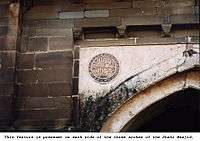
On the outer wall of the mosque are beautiful round designs in which Islamic verses are written in Naqsh script. These verses are surrounded by a Lilly going around the Naqsh script. The Lilly design was later used by Mughals in Tomb of Jahangir, Tomb of Nur Jehan and the Shah Burj Gate in Lahore Fort. The design seems to have been copied from the coins used in that time.
Baolis

There are 3 Baolis in the fort. These were made by cutting deep into the lime rock. They are
The Main Baoli
It is in the middle of the Fort for soldiers, elephants, horses etc. This Baoli has 148 steps. Each step is 20 cm (8 in) wide. The upper portion has been cut in stone. It has three arches that span the length of the baoli.
The Shahi Baoli
It is near the Kabuli Gate for the Royal family. It has 60 steps and has small chambers that were used as baths by the Royal family.
Sar Gate Baoli
A small Baoli near the Sar Gate, most likely used by soldiers.
Rani Mahal


The Rani Mahal (Queens palace) is near Haveli Man Singh. It is a one storey structure. It originally had four rooms but only room remains standing today. The foundation of the four rooms can still be seen today.

It is not an original part of the fort and is an example of Hindu architecture and built around the same time as the Haveli Man Singh.

The room still standing today is about 20 feet (6.1 m) high and beautifully decorated on the inside and outside. The roof of the dome like room is like a flower. The inside of the roof is decorated with flowers, geometrical patterns and fake windows. The room is about 8 by 8 feet (2.4 by 2.4 m).
Decorative features
This fort is an example of purely “Masculine” architecture. It places function over form. This can be gauged from the fact that the fort originally had no permanent building for living.
Stone carvings


These carvings are found on the gate and in the mosque. Most of these are engravings in Arabic and sunflowers.
One of these carvings is inside the Shahi Mosque outside the Pesh Imam's (Prayer leaders) room. The carving is of the word "Allah" (God) in Arabic. The same carving is also done on merlons on top of Shahi Mosque.
The sunflower motif is on each sides of the arches of Shahi Mosque. It is also present in the guard post in between each gate.
Calligraphic inscriptions
Most of these inscriptions are on the Shahi Mosque. On the outer wall of the mosque the “Kalima” is written in beautiful calligraphy on both sides of each arch of the Shahi Mosque. The Naskh script is used.
There is an inscription in Persian on the Shishi gate which gives the date of start of construction. The same inscription is also found over the Talaqi gate.
There are other inscriptions on the Khwas Khani, Langar Khani and Gatali gate.
Glazed tiles
These tiles are found on Shishi gate. This type of tile became extremely popular with the Mughals who further refined them. The tiles on Shishi gate are the earliest example of the usage of these tiles. These tiles were made in Lahore.
Plaster
Plaster has been used in the Shahi Mosque.
Machicolations
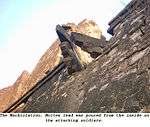
Machicolations are small drains that lead from the inside to the walls outside. They are built into the walls and are used by the soldiers on the inside to pour molten lead or other hot liquids on soldiers trying to scale the walls.
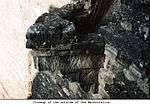
The Rohtas fort has hundreds of them and each one is beautifully decorated with geometric patterns. The pictures is of a machicolation near the Langar Khana (Mess Hall).
Architectural style
This fort was built in the Afghan-Persian architectural style. Afghans and Persians Kings had been coming to the South Asia for at least five centuries before the construction of this fort. Before the construction of this fort, the combination of these styles had not been harmonious. Qila Rohtas is the earliest example of the successful mixing of these two styles with the Afghan style being more prominent.
The elements of Hindu architecture are
- Balconies on Sohail Gate.
- Decorations on Shahi Mosque derived from Hindu architecture.
- Haveli Man Singh (Pure Hindu architecture)
The elements of Afghan architecture are
- Utilitarian construction.
- Use of stone instead of bricks in building wall.
- No living quarters.
- Comparatively less decoration
Usage
Sher Shah Suri died before the completion of this magnificent structure. Ten years after Sher Shah’s death and the end of the Suri dynasty, Emperor Humayun returned to rule India for another 15 years.
When Humayun returned the Governor of Rohtas, Tatar Khan Kasi fled. Ironically, Rohtas then became the capital of the Gakhars, the very people it was designed to crush.
This fort was never popular with the Mughals because of its military character. Emperor Akbar stayed here for a single night. Emperor Jahangir rested here for a single night while going to Kashmir for a rest. He said the following about its location"
This fort was founded in a cleft and the strength of it cannot be imagined
Emperor Jahangir again stayed here when he was being forced to go to Kabul by Mahabat Khan. Nur Jahan, his beautiful and resourceful wife obtained troops from Lahore and ordered Mahabat Khan to release her husband. Emperor Jahangir then proceeded to Rohtas and held his court here for a while. Then he went on to Kashmir and back to Lahore to die.
The later Mughals seem to have made no use of the fort. The reason is that they were allies of the Gakhars and consequently needed no troops to maintain their hold over this area.
Timur Shah Durrani secured Multan from the Sikhs in 1780, his forces then defeated the Sikhs at Rohtas, he then secured Bhawalpur and Kashmir. By 1788 he even attempted unsuccessfully to ford the plains of Punjab to rescue his brother-in-law the emperor Shah Alam II who was blinded by a eunuch Ghulam Qadir, unable to succeed he wrote a letter to Charles Cornwallis, 1st Marquess Cornwallis, requesting that the British protect the Mughal dynasty.[6]
After the takeover of the Punjab by the Ranjit Singh, Sardar General Gurmukh Singh Lamba captured the Rothas Fort from Ghakhar chief Nur Khan, father of Fazil Dad Khan in 1825. due to enmity of Main brothers Raja Gulab and Dahain Singh (Dogra Rajajas) having influence over Maharaja, the fort was given to Mohar Singh. But when Mohor Singh retired to Banaras against the wishes of Maharaja, the fort and the contingent of seven hundred horses were placed under Sardar Gurmukh Singh Lamba. Thus making his command long(Lammbi), he was popularly addressed by the Maharaja as Lammba Sardar. It is also said that the sardar had a medium stature where the Mohar Singh was extra ordinary tall personality, Sardar Gurmukh Singh, got surname of Lamba due to Mohar Singh height. [7] The Maharaja Ranjit Singh gave the fort to Sardar Mohar Singh who was succeeded by Gurmukh Singh Lamba. It was subsequently leased to different people and the last people to manage Rohtas was Raja Fazal Din Khan who joined Sher Singh in rebellion.
Architectural legacy
Here is what the World Heritage list (Document 586) says on page 2 of the report (see references)
Rohtas Fort is an outstanding example of early Muslim military architecture in the South Asia which incorporates features from elsewhere in the Islamic world. It also had a profound influence on the development of architectural styles in the Mughal Empire (and hence on the European colonial architecture that made abundant use of that tradition). It is also outstanding by virtue of the refinement and high artistic value of its decorative elements, notably its high- and low-relief carvings, its calligraphic inscriptions in marble and sandstone, its plaster decoration, and its glazed tiles.
And
There are no surviving examples of military architecture of this period on the same scale in the South Asia which survive to the same degree of completeness and conservation. Fatehpur Sikri (India) which is already on the World Heritage List represents the full Mughal realization of a form and style that owes everything to its precursor, Rohtas Fort.
The recommendation by ICOMOS (the organization that makes the World Heritage list) made the following recommendation
Rohtas Fort is an exceptional example of the Muslim military architecture of central and South Asia, which blends architectural and artistic traditions from Turkey and the South Asia to create the model for Mughal architecture and its subsequent refinements and adaptations.
Present state
Most of the fort is in a very good state of preservation. In the portions that have fallen away (Haveli Man Singh) one can still see some part of the original construction.
The central archway of the Chandwali Gate has been rebuilt recently so that is the only “fake” part of the fort.
In early 2005, seepage, heavy rains, and general neglect caused the left inner face of the Talaqi Gate to collapse, and the right flank and foundation to become detached from the original structure.
The Gatali Gate forms one of the original entrances to Rohtas. Over time, its right bastion and supporting wall have collapsed as a result of permeated rainwater and the erosion of its foundations.
World Heritage Site
Qila Rohtas was designated a World Heritage Site in 1997. Here is what the World Heritage list (Document 586) says on page 3 of the report (see references)
That this property be inscribed on the World Heritage List on the basis of criteria II and IV: Rohtas Fort is an exceptional example of the Muslim military architecture of central and South Asia, which blends architectural and artistic traditions from Turkey and the South Asia to create the model for Mughal architecture and its subsequent refinements and adaptations.
Himalayan Wildlife Foundation
The Rohtas Fort Conservation Programme was conceived by the Himalayan Wildlife Foundation in 2000 to help protect the sixteenth-century Rohtas Fort near Jhelum, and develop it as a heritage site conforming to international standards of conservation and tourism. It is undertaking the following projects in conjunction with the Royal Norwegian Embassy.
Government Eviction Notice
In 1992 the government ordered the locals of rohtas to leave the inside area of fort and state that the government would construct houses for them outside the fort. Zafar Chughtai the chairman of Rohtas opposed the stay order from government declaring that no government will take the properties of rohtas locals.The stay order is still effective but no subsequent government has pursued its execution and has allowed the fort residents to reside there.
- Complete restoration of Shah Chandwali Gate
- Conservation of Haveli Man Singh
- Conservation of Talaqi Gate and Gatali Gate
- Establishment of Sher Shah Suri Museum in upper storey of Sohail Gate
- Improvement of quality of life in Rohtas Fort village
Nearby places of historical significance
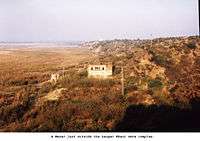
Outside the Langar Khani Gate is the tomb of a lady called Khair Un Nisa. She was the daughter of the food minister named Qadir Bukhsh. She died here and was buried in this tomb but she was later moved to Sasaram.
Until the construction of the new Grand Trunk Road, Rohtas was a halting place on the main Peshawar-Lahore road. This road had serais about a mile apart. One of these is about one mile (1.6 km) north of the Rohtas Fort. It is in a fair state of preservation.
How to visit
From Islamabad
The dual-carriage Grand Trunk Road takes you past Gujar Khan and Sohawa, to the small town of Dina 130 km away. Just past Dina you will drive over a railway overpass, stay to the right of the road and take the first U-turn to drive back towards Dina. After about 100 meters to your left you will find a signpost, which indicates the way towards the road leading to Rohtas Fort which is 8 km away, past the small holy village of Muftian home to the Mufti Tribe. Drive on the road to enter into the fort and keep driving till you reach the parking area.
From Lahore
Drive on G.T. road past Gujranwala, Wazirabad and the city of Jhelum. About 10 minutes drive beyond the Jhelum bridge just short of the city of Dina, you will find a signpost to the left directing you to Rohtas Fort.
Gallery



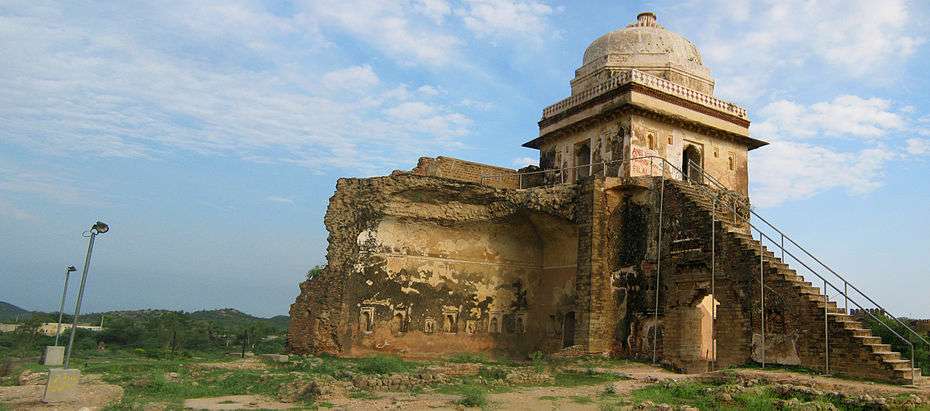


See also
- List of UNESCO World Heritage Sites in Pakistan
- List of forts in Pakistan
- List of museums in Pakistan
- Pothohar Plateau
- Rawat Fort
- Pharwala
- Sar Jalal
- Mankiala Stupa
- Katasraj Temple
References
- Ihsan H Nadiem, Rohtas: Formidable Fort of Sher Shah. Lahore: Sang-e-Meel Publications, ISBN 969-35-0603-0.
- Basheer Ahmad Khan Matta, Sher Shah Suri: A Fresh Perspective. Karachi: Oxford University Press, ISBN 0-19-597882-X.
- Institute of Architects, Pakistan Rawalpindi-Islamabad Chapter Arch Vision 2002”.
- "Rohtas Fort" article by Major General Mian Hayauddin
- ↑ https://books.google.com/books?id=xQGwgJnCPZgC&pg=PA77&lpg=PA77&dq=history+of+rohtas+fort+hemu&source=bl&ots=5B6g9tUaPi&sig=ZCAdGYn3z5iSChtPkNkwaca_jVA&hl=en&sa=X&ei=bvyxUoq8IsizrAe4s4G4Dg&ved=0CGMQ6AEwBw#v=onepage&q=history%20of%20rohtas%20fort%20hemu&f=false
- ↑ https://books.google.com/books?id=d1wUgKKzawoC&pg=PA259&lpg=PA259&dq=bapu+rao+rohtas&source=bl&ots=HKZ-d6bd0f&sig=M6JL53jYpyQRiqZBHyEXZQQIISI&hl=en&sa=X&ei=4_-xUqS6PIT9rAfP_ICQBA&ved=0CEUQ6AEwAw#v=onepage&q=bapu%20rao%20rohtas&f=false
- ↑ http://tribune.com.pk/story/252369/rohtas-fort--the-treasure-of-potohar/
- ↑ Temples of Koh-e-Jud & Thar: Proceedings of the Seminar on Shahiya Temples of the Salt Range, Held in Lahore, Pakistan,by Kamil Khan Mumtaz, Siddiq-a-Akbar, Publ Anjuman Mimaran, 1989, p8
- ↑ nasir khan lodhi
- ↑ https://books.google.com/books?id=Ifs9AQAAQBAJ&printsec=frontcover&dq=history+of+punjab+from+aurangzeb+to+mountbatten&hl=en&sa=X&redir_esc=y#v=onepage&q=Timur%20Shah%20Rohtas&f=false
- ↑ References [a]Punjab Chiefs -Sir Lepel Griien [b]Sun-Sohan, Famlies and Note of Punjab- Charles Massy [c]Caption Serial-D-40 General Sardar Gurmukh Singh Lamba-Central Museum Lahore.
External links
| Wikimedia Commons has media related to Rohtas Fort. |
- UNESCO World Heritage Centre Web page. It has a panograph of the Qila Rohtas.
- Rohtas Conservation page on the Himalayan Wildlife Foundation website
- Rohtas fort latest pictures
